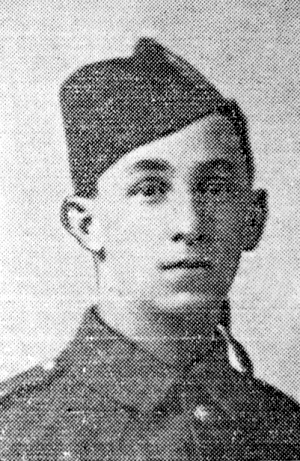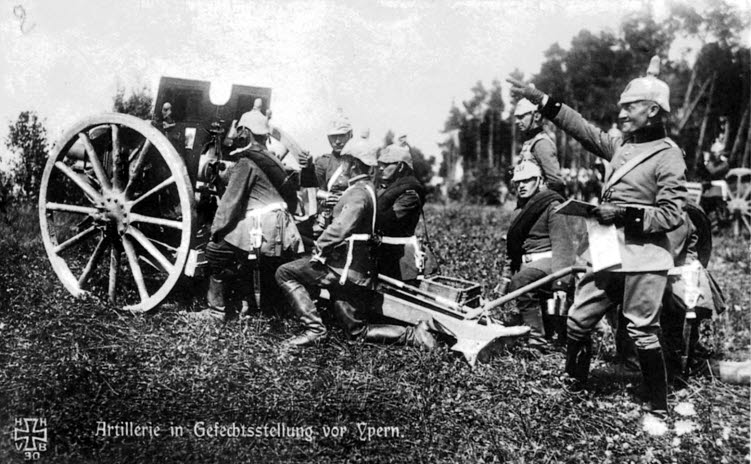
William, or Willie Nettleton was born in Ossett on the 15th July 1891, the sixth son and ninth child of cloth finisher Robert Nettleton and his wife, Elizabeth or Betsy (nee Roling), who married at Dewsbury All Saints Church on the 16th November 1873. Willie Nettleton was baptised at Holy Trinity Church on the 6th September 1891. The couple had twelve children from their marriage, but one child died before April 1911. All of the Nettleton family were born in Ossett.
In 1901, Willie was living with his parents and his six brothers and four sisters on Back Lane, Ossett. His parents had lived there since their marriage and this was probably the house in which he was born. In 1911, aged 19 years, he was living with his parents, Robert and Betsy Nettleton, four brothers and a sister, in the same two-roomed home at 13, Ventnor Cottages, Back Lane, Ossett. Willie’s father Robert was a mill hand, but in 1911 was currently out of work, aged 57. Willie was working as a shop assistant. Willie’s elder brother, George Nettleton, also served in the army in World War 1 and lost his life.
William Nettleton’s army service record has not survived. but it is known that he enlisted at Ripon in early 1916, and joined the Queen’s Own Cameron Highlanders with service number 5104. He embarked for France in July 1916 and was killed in action on the 17th August 1916. He was posthumously awarded the British and Victory medals.
The 1st/4th Battalion of the Queen’s Own Cameron Highlanders was formed in August 1914 at Inverness as part of Seaforth and Cameron Brigade in the Highland Division. The Battalion moved to Bedford on the 20th February 1915, left the Division and landed at Le Havre. Three days later they joined 24th Brigade in 8th Division on the Western Front. On the 8th April 1915, they transferred to 21st Brigade in 7th Division and on the 20th December 1915 they transferred to 91st Brigade in same Division. On the 7th January 1916, the Battalion transferred again, this time to the 154th Brigade in the 51st (Highland) Division. Then, on the 28th February 1916, they left the Division, moved to base and the Battalion was disbanded.
It is known that more than 300 of the 1/4th Battalion men were sent to join the 1st Entrenching Battalion, a collection of men of mixed regiments that was used to provide manual labour behind the lines, before the establishment of the Labour Corps in 1917. Just over 100 remained as a ‘Base’, but what they actually did is unknown. Whatever was left of the old 1/4th Battalion joined the 1st Battalion Cameron Highlanders in the field in late 1916 in the 1st Brigade of the 1st Division.
In June 1916, men from the Camerons base depot at Etaples and from the No. 1 Entrenching Battalion previously with the 4th Camerons were sent to join the 1st Camerons at Les Brebis. These men brought the strength of the 1st Cameron Highlanders up to 1,033 men, a good strength for a battalion on the front line during WW1. It meant that ten officers and 174 men of the 4th Cameron Highlanders were now serving with the 1st Battalion.
The 1st Camerons moved to the Somme sector on the 6th July, taking over the front line trenches the day after arriving at Albert. The trenches, called ‘Scott’s Redoubt’, were an old German trench system between the villages of Becourt and Contalmaison. Their first tour of the region was in support of the battalions that were attacking Contalmaison between the 10th and 14th July.
On the 21st July 1916, the 1st Cameron Highlanders took over the front line trenches at Bazentin Le Petit Wood. On the morning of the 23rd July, the 1st Camerons and the 10th Gloucester Regiment launched an attack on the road from Bazentin le Petit to Martinpuich from trenches just north of the former village. ‘C’ Company led the way and reached the German lines, but were repulsed by bombs, rifle and machine-gun fire. The attack had failed and they dug in until they could be relieved. The 1st Cameron Highlanders lost 65 men killed and 129 men wounded, including 15 men from the 4th Camerons killed and 20 wounded.
On the 11th August 1916, the 1st Cameron Highlanders received a draft of 65 men from the Cameron Highlanders base depot in Etaples, all of whom were recently arrived men of the 3/4th Camerons. They were soon to get their first taste of action. The 1st Cameron Highlanders were in action from the 16th to 20th August 1916. Fifteen men of the 4th Camerons were killed and 20 wounded in heavy German shelling out of a total of 42 killed and 80 wounded for the battalion.1
Private William Nettleton died on the 17th August 1916 almost certainly as a result of the German shelling referenced above. His body was never recovered.
The “Ossett Observer” 2 had this obituary for William Nettleton:
“Well-Known Ossett Soldier Killed In Action – The First Local King’s Scout – We intimated in our last issue that anxiety was felt as to the welfare of Lance-corporal William Nettleton (24), of the 4th Cameron Highlanders, whose parents reside at 13, Ventnor-cottages, Back-lane, Ossett. The sad news came to hand on Monday morning that he was killed in action on the western front on August 17th. A local hairdresser, of genial disposition, the young soldier was well-known. As a boy he was prominently associated with the scout movement, and was recently the first King’s scout in Ossett, and more recently held the position of warrant assistant scoutmaster to the local troop. He joined the forces early this year, and went to France during July. A few weeks ago he sent a postcard home, stating that he was going up the line to the front, and that probably he would not be able to write again for a few weeks. That was the last message received from him.
One of his brothers, Lance-corporal George Nettleton, of the King’s Own Yorkshire Light Infantry, who formerly worked at a Horbury athletic good manufactory, has been at the front for several months. The brothers met in the fighting area a few weeks ago.
Private Oliver Nettleton, of the Northumberland Fusiliers, well-known as the conductor of the Borough Brass Band; and Driver John Robert Nettleton, of the Royal Field Artillery, are brothers of the deceased. The former is in training at Strensall and the latter, when last heard of, several weeks ago, was sailing, he believed, for India.
Two of the deceased’s brothers-in-law are with the forces, namely, Sergeant Harry Tallett and Private Joe Terry, both of the King’s Own Yorkshire Light Infantry, now stationed in Suffolk.”

Above: German artillery position during WW1
Private William Nettleton, aged 24 years, son of Robert Nettleton, of 13, Ventnor Cottages, Back Lane, Ossett, died on the 17th August 1916. He is is remembered on Pier and Face 15B at the Thiepval Memorial 3, Somme, France. The Thiepval Memorial can be found on the D73, next to the village of Thiepval, off the main Bapaume to Albert road (D929).
On 1 July 1916, supported by a French attack to the south, thirteen divisions of Commonwealth forces launched an offensive on a line from north of Gommecourt to Maricourt. Despite a preliminary bombardment lasting seven days, the German defences were barely touched and the attack met unexpectedly fierce resistance. Losses were catastrophic and with only minimal advances on the southern flank, the initial attack was a failure. In the following weeks, huge resources of manpower and equipment were deployed in an attempt to exploit the modest successes of the first day. However, the German Army resisted tenaciously and repeated attacks and counter attacks meant a major battle for every village, copse and farmhouse gained. At the end of September, Thiepval was finally captured. The village had been an original objective of 1 July. Attacks north and east continued throughout October and into November in increasingly difficult weather conditions. The Battle of the Somme finally ended on 18 November with the onset of winter.
In the spring of 1917, the German forces fell back to their newly prepared defences, the Hindenburg Line, and there were no further significant engagements in the Somme sector until the Germans mounted their major offensive in March 1918.
The Thiepval Memorial, the Memorial to the Missing of the Somme, bears the names of more than 72,000 officers and men of the United Kingdom and South African forces who died in the Somme sector before 20 March 1918 and have no known grave. Over 90% of those commemorated died between July and November 1916. The memorial also serves as an Anglo-French Battle Memorial in recognition of the joint nature of the 1916 offensive and a small cemetery containing equal numbers of Commonwealth and French graves lies at the foot of the memorial.
References:
1. “Steel and Tartan: The 4th Cameron Highlanders in the Great War”, by Patrick Watt, published by the The History Press (1st March 2012), ISBN-10: 0752465775 and ISBN-13: 978-0752465777
2. “Ossett Observer”, September 1916